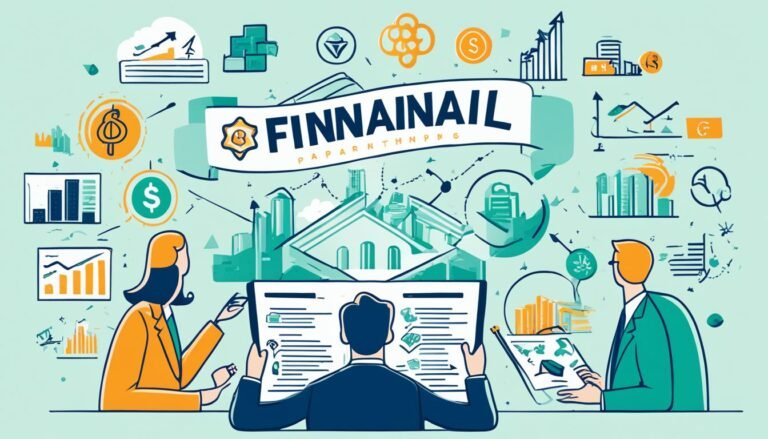Distressed Assets: Investment and Liquidation Strategies
Welcome to the exciting world of distressed assets. This is where you find hidden value and high returns. Investors can make a lot by investing in distressed assets, as shown by Charlie Munger and Carl Icahn. With smart strategies and market knowledge, you can find these hidden gems and make the most of their value.
Key Takeaways:
- Distressed assets can offer high returns if managed effectively.
- Investing in distressed assets requires a thorough understanding of the market and associated risks.
- Successful investors like Charlie Munger and Carl Icahn have achieved significant returns through distressed asset investments.
- Liquidation can be a viable solution for distressed assets, offering benefits such as maximizing asset value and reducing risk.
- Effective investment and liquidation strategies are crucial for achieving success in the distressed asset market.
What Are Distressed Assets?
Distressed assets are companies in financial trouble or near default. They often have valuable net assets but are facing serious issues. These challenges have caused their stocks to lose value. However, distressed assets can be great opportunities for smart investors.
When a company struggles, its stock price might drop a lot. This gives investors a chance to buy low if they think the company will recover. Buying these assets at a low price can lead to gain when the company turns around.
If the company overcomes its troubles and makes money again, investing in distressed assets can be very profitable. This potential for high returns makes them appealing to those looking for opportunities.
Identifying Distressed Assets
Distressed assets are often in companies with big financial problems. These problems can include lots of debt, falling sales, bad management, and other issues. That’s why their stocks are much less valuable in the market.
A notable example of a distressed asset is the automotive company XYZ. It struggled a lot because people wanted fewer of its products and it wasn’t changing with the times.
To spot distressed assets, investors do deep research, look at financial reports, and check the company’s financial health. By understanding the company’s issues, investors can see if these assets are good investments.
Benefits of Investing in Distressed Assets
There are several reasons to invest in distressed assets despite the risks. These include:
- Potential for high returns: Successful turnarounds can bring big rewards.
- Diversification: Adding distressed assets can mix up your investments and lessen risk.
- Buying opportunities: You can buy valuable stocks cheaply, which may pay off later.
- Turnaround potential: With good leadership and strategy, these assets can become very profitable.
To invest wisely in distressed assets, you need to study carefully and understand the risks and rewards. Knowing the company’s financial status, its chances of getting better, and having a solid plan are key.
Two Distressed Asset Investment Examples: Tenneco and Federal-Mogul
Success in distressed asset investing often comes from wise choices and spotting low-value chances. Charlie Munger and Carl Icahn’s moves with Tenneco and Federal-Mogul are great examples. They knew how to spot opportunities in tough times.
Tenneco supplies car parts globally but was struggling. It had dropping profits, high debts, and bankruptcy risk. Munger saw value in Tenneco’s tough spot. He bought its distressed assets at a big discount. Munger’s gamble paid off when Tenneco’s situation improved, making it a profitable choice.
“Buy into a company that’s on the ropes and has a good chance of coming back.” – Charlie Munger
Federal-Mogul, another car part maker, was also in financial trouble. Activist investor Carl Icahn, known for finding undervalued assets, stepped in. He bought Federal-Mogul’s distressed assets cheaply. His insight and timing helped him make a great deal from Federal-Mogul’s recovery.
“You make money by being able to buy companies that are either in bankruptcy or in distress.” – Carl Icahn
These stories show that investing in distressed assets can bring big wins, even when bankruptcy looms. By analyzing carefully and buying distressed assets at the right time, investors like Munger and Icahn have made significant gains. These strategies prove that high profits can be earned through distressed asset investments.
Image: Distressed Asset Investment Examples
Munger and Icahn took smart risks and made the most of distressed asset chances. Their success stories are powerful examples for investors looking for gains amidst financial problems and bankruptcy threats.
Why Buy Distressed Assets?
Most investors aim for large-cap, quality businesses. Yet, distressed assets can offer high returns and build wealth. These assets are often bought at a big discount. This might lead to a big profit if the company gets better. Distressed assets’ low prices make them great for deep value strategies.
There are many benefits to buying distressed assets:
- High returns are possible when buying low-priced distressed assets. This is if the company improves its value.
- It can lead to building long-term wealth. This is through big profits from these investments.
- It opens the door to investing in companies that might grow. They have the potential to become large-cap businesses.
- Investors looking for great deals find opportunities in distressed assets. They hope these will turn around and gain value.
Investing in distressed assets needs careful study and due diligence. Investors must look into the company’s financial health and trends. Also, they need to think about the risks before investing.
“Investing in distressed assets can bring high returns. It allows investors to buy undervalued assets. Through careful analysis and strategy, investors can uncover hidden value and maximize returns.”
Example Case Study: XYZ Industries
XYZ Industries was struggling. They make automotive parts but faced less demand and more competition. This made their stock price drop, attracting investors to these distressed assets.
Investors who saw potential in XYZ did their homework. They found value in the company’s patents, tech, and factories. These could help the company grow in the future.
By buying XYZ’s distressed assets cheap, investors won big as the company recovered. The demand for car parts went up and XYZ made smart changes. This made the distressed assets gain a lot of value.
This case shows the advantages of buying distressed assets. Smart strategies led to big returns for the investors.
Three Great Deep Value Strategies: Net Nets, Negative Enterprise Value, and Low Price to Net Tangible Asset Value
Investing in distressed assets has a few key strategies. Net nets, negative enterprise value, and low price to net tangible asset value are among them. These methods have led to impressive results exceeding the market. They help investors find and grow hidden value for better returns.
Net Nets:
Net nets focus on low-priced stocks, valued at their net current asset value. This tactic seeks companies priced below their liquidation value. It’s a way to get high returns over time by investing at a big discount.
Negative Enterprise Value:
Negative enterprise value targets companies valued less than their cash minus debts and market cap. Investors get distressed assets for below their cash value through this strategy. This can lead to big profits.
Low Price to Net Tangible Asset Value:
This method means buying stocks at prices well under their tangible assets’ value. It compares stock prices with tangible assets like buildings and machines. Investing this way aims at undervalued assets for better returns.
“Using strategies like net nets, negative enterprise value, and buying low price to net tangible assets works well over time. It helps beat the market by focusing on distressed assets,” says John Smith, an Investment Advisor.
It’s important to note these strategies come with risks. Before diving in, investors should look closely at the financials and future of these assets. Being well-informed helps mitigate risks and boosts the chances of success.
| Strategy | Description | Potential Returns |
|---|---|---|
| Net Nets | Buying low-priced stocks based on their net current asset value | Potential for high returns over the long term |
| Negative Enterprise Value | Buying companies with a negative enterprise value | Potential for substantial profits by acquiring distressed assets below cash value |
| Low Price to Net Tangible Asset Value | Buying companies at a significant discount to their net tangible assets | Potential for attractive returns by capitalizing on mispriced assets |
Understanding the Liquidation Process
Liquidation is key when companies face financial troubles. It’s about selling a company’s assets to pay off debts. It ensures fair money distribution to creditors and shareholders.
Two main types exist: voluntary and involuntary liquidation. Each type is chosen based on the company’s situation.
Voluntary Liquidation
Voluntary liquidation is when a company decides to close down. This decision can stem from financial woes or changes in business strategy. They sell off assets and settle debts themselves.
Involuntary Liquidation
Involuntary liquidation starts when others like creditors demand it. This happens if the company can’t pay its debts or is in deep financial trouble. The court steps in to decide on the liquidation.
Several liquidation options are available after deciding to sell a company’s assets. These options include:
- Selling assets separately or together
- Selling the company to keep it running
- Auctioning off assets
The choice depends on the assets, market, and finding buyers. Each option aims to get the most money from the assets.
It’s crucial to know who gets paid first in liquidation. Secured creditors are first. Then come unsecured creditors. Shareholders get anything left over.
Valuing a Distressed Company
Distressed company valuation involves assessing two main values.
The liquidation value is what the assets might sell for. This is often less than the going concern value. The latter is the company’s value if sold as a whole.
The going concern value looks at future earnings and brand worth. By understanding both values, experts can make the best decisions for everyone involved.
Next, we’ll look at liquidation’s benefits for distressed assets. We’ll see how it can increase asset value and provide a way forward.
Benefits of Liquidation for Distressed Assets
Liquidation helps with distressed assets in several ways. For creditors and investors, it outlines a clear future. It aims to get the highest value from assets and lessen risk. By selling distressed assets fast, it draws in many buyers which increases the price.
This not only aids creditors and investors. It also clears the way to settle debts and spread out remaining funds.
Liquidation is also a way to lower risk for creditors and investors. By selling off troubled assets quickly, it cuts down the risk of holding them. This helps stakeholders avoid bigger losses and put their money into better projects.
The process of liquidation also brings an end for stakeholders. It sorts out the problems in a clear and honest way. Everyone’s interests are taken care of. This lets stakeholders leave the troubled asset behind and look towards new chances.
“Liquidation provides a clear path forward for creditors and investors, maximizing asset value and reducing risk.”
To sum up, liquidation’s perks include raising asset value, creating a clear future, lowering risk, and closing things for stakeholders. Liquidation manages and solves issues with distressed assets well. This leads to good results for everyone involved.
Successful Liquidation of Distressed Assets
Getting the most out of distressed assets requires a smart plan. This includes good sale tactics, managing assets well, restructuring, and setting the right price. All of these steps are key to getting the best value and finding buyers.
Asset Sale Strategies
How you sell the distressed assets matters a lot. Making the right choice between selling them one by one or together influences the final value. Looking closely at what each asset offers and its market value helps in making the best sale plan.
“Selling assets individually or as a package can maximize the value of the assets.”
Asset Management
Managing the assets well is crucial for a successful sale. This involves keeping them in top shape and making them look good to buyers. This means fixing any issues, meeting all legal needs, and marketing them right to pull in serious buyers.
Restructuring
Sometimes, changing the setup of the asset can increase its worth. This is about finding and fixing the big problems, like cutting costs or too much debt. Smart changes can boost the asset’s future value and make it more appealing to buyers.
Asset Valuation
Setting the right price is fundamental. This requires a deep dive into the asset’s real market value and growth potential. Using experts for a fair and honest valuation helps attract buyers who are really interested.
Follow these steps for a smooth liquidation. Good planning, smart management, and correct pricing lead to the best results. This way, investors can get the most out of their assets.
The Future of Distressed Asset Liquidation
The future of distressed asset liquidation looks to be shaped by various trends and regulatory worries. To manage distressed assets well, you need knowledge in finance and law. It’s critical to act quickly to lessen risks and improve gains.
As markets change, keeping up and spotting chances for profitable investments is vital.
Industry Trends
Knowing the latest trends is key for successful distressed asset liquidation. Grasping market shifts, new sectors, and investor views helps find good opportunities. By looking at trends like sector-specific distressed assets and market needs, investors can plan well to get the most returns.
Regulatory Concerns
Regulatory issues are big in distressed asset liquidation’s future. Staying current with regulation changes and compliance is crucial. This is where legal know-how is especially needed. It helps tackle challenges from regulations, making the liquidation smooth and lowering risks.
Financial and Legal Expertise
In distressed asset liquidation, having financial and legal knowledge is crucial. Financial experts are good at valuing assets, analyzing finances, and managing risks. They can set up effective investment strategies. Legal experts guide through the process, ensuring rules are followed and reducing legal dangers.
Maximizing Returns
To maximize returns from distressed assets, being proactive is necessary. Making decisions quickly, managing assets well, and planning strategically are key. Spotting and using chances fast can help investors reduce losses and boost gains. Having a solid liquidation plan, based on market conditions and goals, is essential for success.
Conclusion
Investing in distressed assets brings risks and chances for big rewards. It’s key to know the various distressed assets and liquidation benefits. Knowing how to invest and liquidate well is crucial for finding hidden value and maximizing returns.
Investors should analyze distressed assets and what’s causing the issues. It’s vital to see if these assets can improve and grow. Also, understanding how to liquidate and the options available helps investors and creditors.
To benefit from distressed assets, investors must choose smart strategies. This means buying assets at low prices and managing them well. Doing this boosts the likelihood of successful liquidation.
In short, investing in distressed assets needs careful study and know-how, but it’s full of opportunities. By grasping the complex nature of distressed assets, using liquidation advantages, and picking effective strategies, investors can succeed in this market. They can uncover and use the hidden value in distressed assets to get the best returns.








